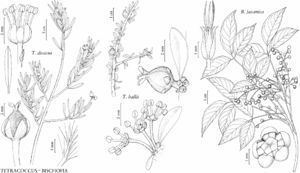Bischofia
Bijdr. Fl. Ned. Ind. 17: 1168. 1827.
| Taxon | Illustrator ⠉ | |
|---|---|---|
 | Tetracoccus hallii Bischofia javanica Tetracoccus dioicus | Barbara Alongi |
Trees, usually dioecious, rarely monoecious, hairy, becoming glabrate, hairs simple; branching not phyllanthoid. Leaves deciduous, alternate, pinnately compound, leaflets 3 (or 5), all well developed; stipules fugacious; blade margins crenate-serrate. Inflorescences unisexual, racemose or paniculate thyrses. Pedicels present. Staminate flowers: sepals 5, distinct; petals 0; nectary absent; stamens 5; filaments distinct, adnate to pistillode base; connectives not extending beyond anthers; pistillode short-stipitate, peltate, 5-angled. Pistillate flowers: sepals deciduous, 5, distinct; petals 0; nectary absent; pistil 3 (–4) -carpellate; styles 3 (–4), connate at base, unbranched. Fruits drupes. Seeds 1–2 per locule, rounded-trigonous; seed-coat dry, smooth; caruncle absent. x = 14.
Distribution
Introduced; Fla., s, e Asia, Pacific Islands, Australia, also in s, e Africa
Discussion
Species 2 (1 in the flora).
Bischofia is distinctive in Phyllanthaceae by virtue of its pinnately compound leaves. H. K. Airy Shaw (1967b) placed it in his monogeneric Bischofiaceae, but embryological and anatomical data (A. K. Bhatnagar and R. N. Kapil 1973; G. A. Levin 1986b; A. M. W. Mennega 1987; G. L. Webster 1994) argue against its separation from other Phyllanthaceae. Molecular data reveal Bischofia to be a somewhat isolated early-divergent lineage of Phyllanthaceae subfam. Antidesmatoideae Hurusawa (H. Kathriarachchi et al. 2005; P. Hoffmann et al. 2006). Bischofia javanica is sometimes cultivated as a street tree in tropical regions. The second known species, B. polycarpa (H. Léveillé) Airy Shaw, is endemic to subtropical China.
Selected References
Lower Taxa
"connate" is not a number.